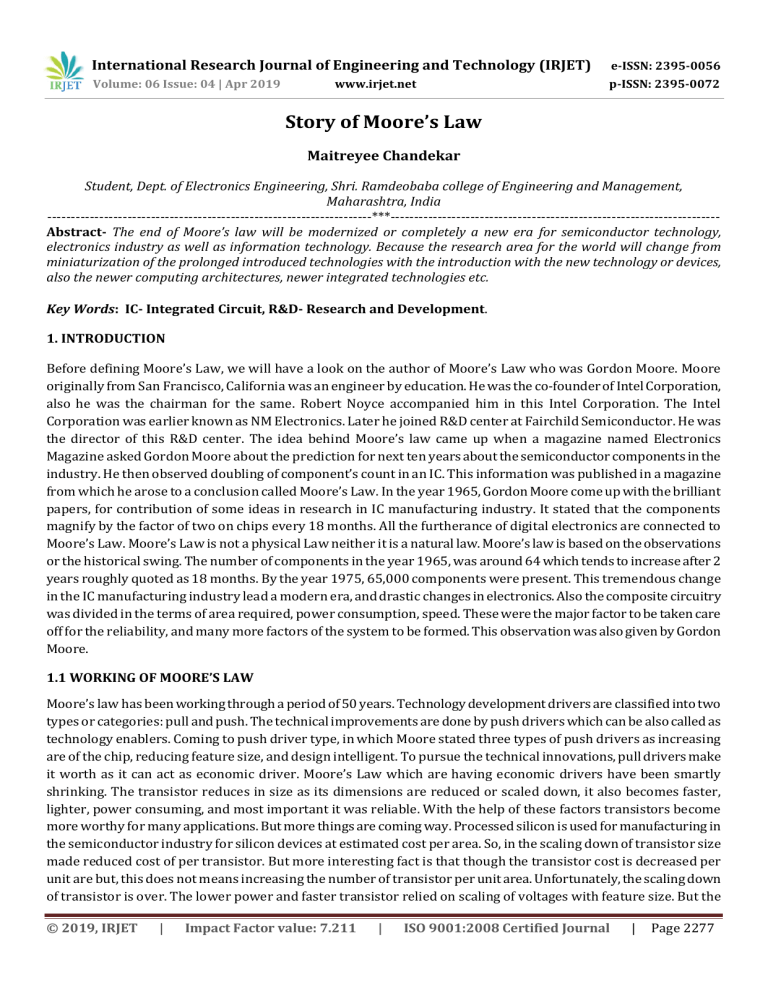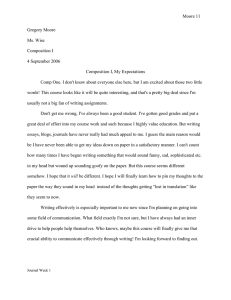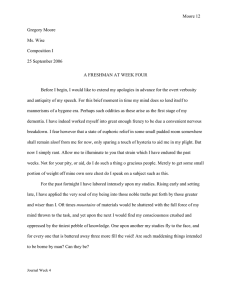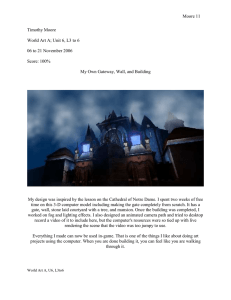IRJET- Story of Moore’s Law
advertisement

International Research Journal of Engineering and Technology (IRJET) e-ISSN: 2395-0056 Volume: 06 Issue: 04 | Apr 2019 p-ISSN: 2395-0072 www.irjet.net Story of Moore’s Law Maitreyee Chandekar Student, Dept. of Electronics Engineering, Shri. Ramdeobaba college of Engineering and Management, Maharashtra, India ---------------------------------------------------------------------***---------------------------------------------------------------------Abstract- The end of Moore’s law will be modernized or completely a new era for semiconductor technology, electronics industry as well as information technology. Because the research area for the world will change from miniaturization of the prolonged introduced technologies with the introduction with the new technology or devices, also the newer computing architectures, newer integrated technologies etc. Key Words: IC- Integrated Circuit, R&D- Research and Development. 1. INTRODUCTION Before defining Moore’s Law, we will have a look on the author of Moore’s Law who was Gordon Moore. Moore originally from San Francisco, California was an engineer by education. He was the co-founder of Intel Corporation, also he was the chairman for the same. Robert Noyce accompanied him in this Intel Corporation. The Intel Corporation was earlier known as NM Electronics. Later he joined R&D center at Fairchild Semiconductor. He was the director of this R&D center. The idea behind Moore’s law came up when a magazine named Electronics Magazine asked Gordon Moore about the prediction for next ten years about the semiconductor components in the industry. He then observed doubling of component’s count in an IC. This information was published in a magazine from which he arose to a conclusion called Moore’s Law. In the year 1965, Gordon Moore come up with the brilliant papers, for contribution of some ideas in research in IC manufacturing industry. It stated that the components magnify by the factor of two on chips every 18 months. All the furtherance of digital electronics are connected to Moore’s Law. Moore’s Law is not a physical Law neither it is a natural law. Moore’s law is based on the observations or the historical swing. The number of components in the year 1965, was around 64 which tends to increase after 2 years roughly quoted as 18 months. By the year 1975, 65,000 components were present. This tremendous change in the IC manufacturing industry lead a modern era, and drastic changes in electronics. Also the composite circuitry was divided in the terms of area required, power consumption, speed. These were the major factor to be taken care off for the reliability, and many more factors of the system to be formed. This observation was also given by Gordon Moore. 1.1 WORKING OF MOORE’S LAW Moore’s law has been working through a period of 50 years. Technology development drivers are classified into two types or categories: pull and push. The technical improvements are done by push drivers which can be also called as technology enablers. Coming to push driver type, in which Moore stated three types of push drivers as increasing are of the chip, reducing feature size, and design intelligent. To pursue the technical innovations, pull drivers make it worth as it can act as economic driver. Moore’s Law which are having economic drivers have been smartly shrinking. The transistor reduces in size as its dimensions are reduced or scaled down, it also becomes faster, lighter, power consuming, and most important it was reliable. With the help of these factors transistors become more worthy for many applications. But more things are coming way. Processed silicon is used for manufacturing in the semiconductor industry for silicon devices at estimated cost per area. So, in the scaling down of transistor size made reduced cost of per transistor. But more interesting fact is that though the transistor cost is decreased per unit are but, this does not means increasing the number of transistor per unit area. Unfortunately, the scaling down of transistor is over. The lower power and faster transistor relied on scaling of voltages with feature size. But the © 2019, IRJET | Impact Factor value: 7.211 | ISO 9001:2008 Certified Journal | Page 2277 International Research Journal of Engineering and Technology (IRJET) e-ISSN: 2395-0056 Volume: 06 Issue: 04 | Apr 2019 p-ISSN: 2395-0072 www.irjet.net factor noise cannot be scaled down. In the early decade, the noise limit was overdriven by voltage scaling. The two qualities of lower voltage scaling and making the transistor lower power and faster is not possible the both way. This way the economic drivers of the Moore’s law only explains the actual Moore’s law but it doesn’t specify how the Moore’s law is going to work. 2. LIMITS OF MOORE’S LAW Semiconductor manufacturing is done by a method of scaling, this is a direct consequence which is very unique that is the Moore’s law: The cost of manufacturing per unit area, also the lower cost per functioning is given by the increase in transistor density. Moore’s Law can be considerably affected by the economic parameters. It seems that the Moore’s law and semiconductor industry are in the middle of a perfect storm. Semiconductors when used as electronic devices are nearly at saturation. So, the growth of the semiconductors is limited in the electronics industry growth. The reason for scaling of transistors is to make them cheaper which is done by voltage scaling factors. As the device dimensions are shrinking the introduction of newer manufacturing technology that is lithography does not keep the manufacturing cost low. Actually the limits of reaching the feature size to minimum by scaling it down are ending, still the innovations in electronics and manufacturing will continue. At present the 50 years of Moore’s law is satisfied in the industry and by the world and yet many more years are left for its extinction. REFERENCES [1]It’s Time to Redefi ne Moore’s Law Again Erik P. DeBenedictis, Sandia National Laboratories. [2] Fifty Years of Moore’s Law Chris A. Mack, Fellow, IEEE [3] The End of Moore’s Law: A New Beginning for Information TechnologyThomas N. Theis, H.-S. Philip Wong BIOGRAPHIES Maitreyee Chandekar M.Tech (VLSI Design) Dept. of Electronics Engineering, Shri. Ramdeobaba college of Engineering and Management, Maharashtra, India © 2019, IRJET | Impact Factor value: 7.211 | ISO 9001:2008 Certified Journal | Page 2278




